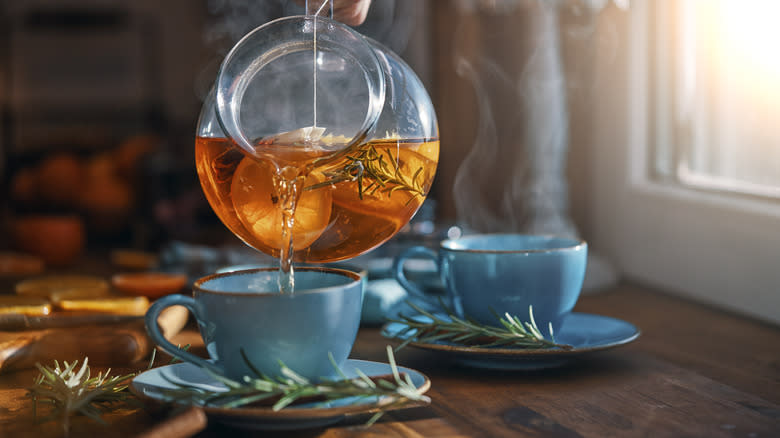The Rule Of Thumb To Follow When Pairing Tea With Food

Tea isn't just for croissants and tiny finger sandwiches. It's a stand-out beverage to pair with any meal, and like a sommelier versed in the art of fine wine, the discerning sipper understands that tea is a nuanced medium. In the same way that certain wines pair well with some foods and not others (Cabernet Sauvignon with ribeye steak, Sauvignon Blanc with fish, etc.), pairing tea with food is all about balance. As a general rule, start with the meal first, and then choose the best tea to complement its characteristics.
If the entree is more delicate, like fish, pasta, or roasted veggies, a more understated tea might be the way to go to avoid competing flavors — green tea or white tea can be ideal here. Other times, when serving meals with bolder flavors, you'll need a rich, full-bodied tea that won't get lost in the mix. Stronger herbal teas and black teas are the way to go for dishes like these.
Also, keep in mind that brewing times and temperatures can greatly affect your tea's flavor profile. You might steep a given tea for more or less time depending on how "much" of its flavor you want to pair with your dish. For instance, a hibiscus herbal tea might lend a pleasant herbaceous, floral note when paired with saffron couscous, but steep it for too long, and a stronger hibiscus flavor could overpower the delicate entree. It's all about nailing the right amount of flavors and aromas for your food pairing.
Read more: 15 Boba Flavors, Ranked Worst To Best
Know Your Leaf Lexicon

As a jumping-off point, black teas have the most tannin-forward profiles, toting slight astringency and maltiness. Like red wines, these pair well with dark meats and more robust entrees. Pair a strong, smoky, savory tea like Lapsang Souchong with dumplings; for brunch, "breakfast" teas fittingly hold up well to heartier foods like sausage, eggs, and waffles; floral Earl Grey pairs well with spicy Indian food.
Green teas are either vegetal, smoky, or floral, pairing well with stir-fries, potatoes, rice dishes, and light meats. Enjoy grassy, bitter Japanese sencha tea with an entree salad, smoky gunpowder tea with roasted chicken, or iced jasmine tea with grilled fish.
Oolong is the class of tea between black and green, and as such, oolongs can be light or heavy, fitting a wide range of dishes, especially seafood and shellfish. In general, white teas should be paired with food sparingly, as their delicate flavor can be quickly lost. You could pair Pai Mu Tan white tea with roasted veggies for a light, floral taste — some cooks even incorporate these tea bags into their soups and sauces for added flavor.
At the dinner table, herbal teas are in a class of their own, ranging from smoky (red rooibos) to floral (rosehip) and beyond. As such, feel free to get creative with these. You could pair lemongrass ginger tea with a bowl of steaming pho. Peppermint tea also makes a killer palate cleanser between courses or at the end of a larger meal.
Read the original article on Tasting Table.


